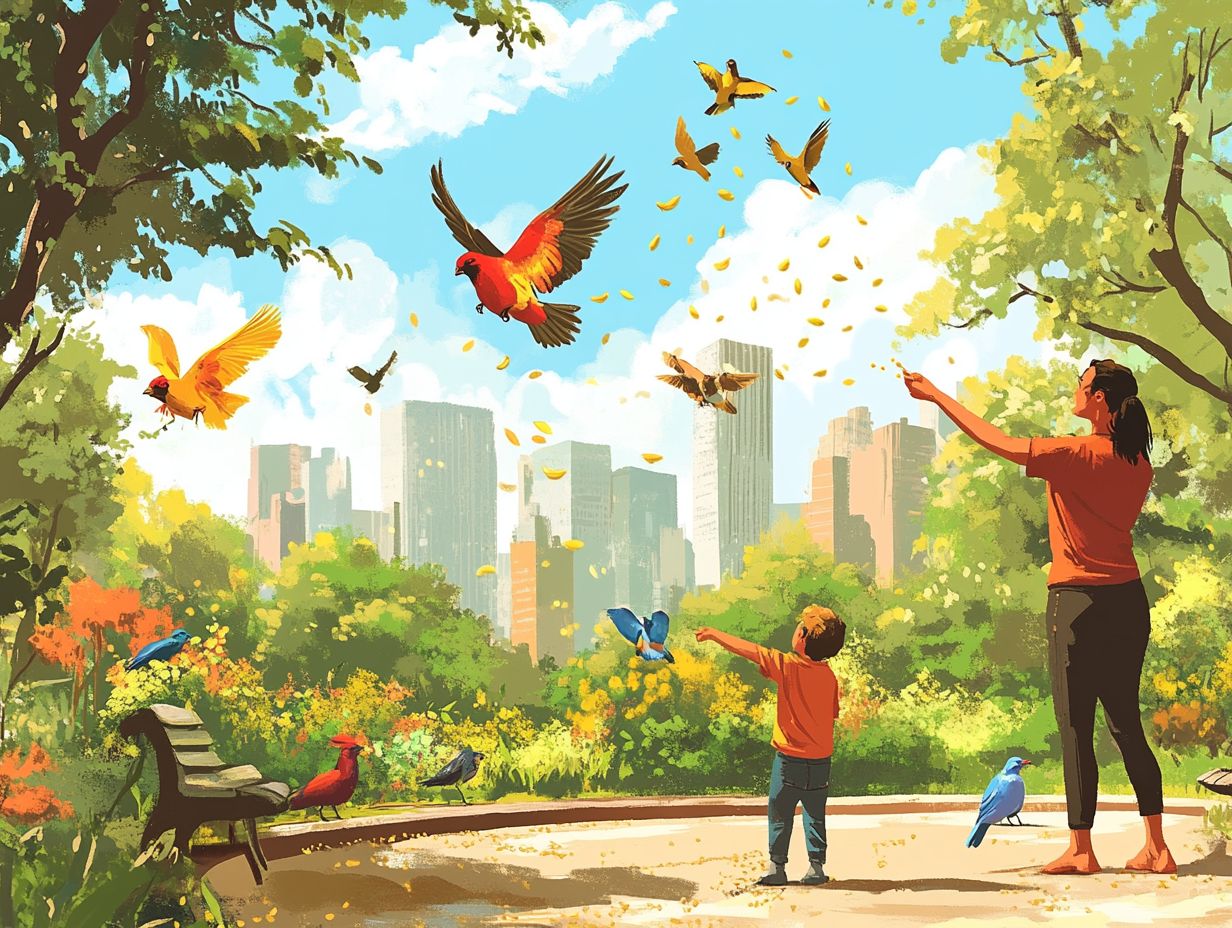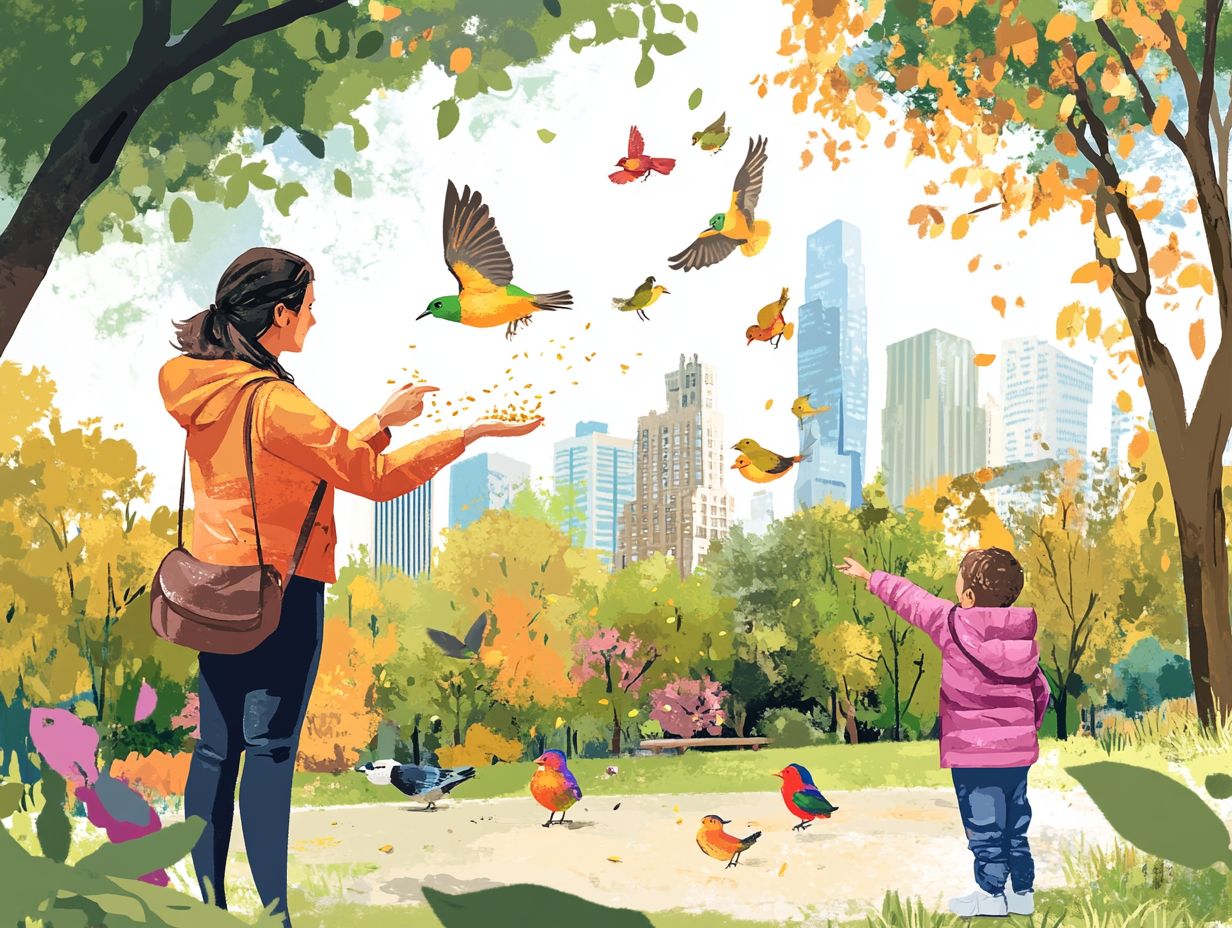Urban bird feeding is not just an enjoyable pastime; it is a vital intervention for local wildlife and enhances our daily lives.
As urban spaces continue to expand, creating safe havens for our feathered friends becomes increasingly important. This article discusses the benefits of bird feeding, outlines essential do’s and don’ts for attracting birds, highlights common species to observe, and provides tips for maintaining a bird-friendly environment throughout the different seasons.
Join us in transforming your urban space into a welcoming oasis for birds!
The Importance of Urban Bird Feeding

Feeding birds in urban areas plays a vital role in our interaction with wildlife, fostering relationships with avian species that enhance our urban ecosystem. Individuals can provide food sources through feeders and seed mixes, significantly impacting local bird populations, especially in urban environments where natural habitats are scarce.
Urban bird feeding not only addresses the nutritional needs of birds but also promotes biodiversity and supports wildlife conservation efforts, allowing communities to engage in responsible interactions with nature. Additionally, if conducted using eco-friendly backyard practices, bird feeding can have a positive environmental impact.
Benefits for Birds and Humans
Feeding birds in your backyard offers numerous benefits for both humans and birds, enhancing the birdwatching experience and fostering a deeper connection to nature. By using various bird feeders, seed mixes, and feeding techniques, individuals can create an environment that attracts diverse bird species. This practice allows people to observe bird behavior up close, providing therapeutic benefits while simultaneously supporting their avian friends.
By providing essential nutrition that helps birds thrive, this enjoyable pastime also enriches the daily lives of those who participate. Observing the different species that come to feed can increase wildlife appreciation and improve mental health by reducing stress and promoting mindfulness. Additionally, connecting with birds can spark curiosity and encourage learning about local ecosystems, fostering a stewardship ethic towards nature.
Urban bird feeding creates a win-win situation where both the birds and those who feed them benefit immensely.
Do’s for Attracting Avian Friends

To successfully attract birds to your backyard, it’s important to follow some best practices in bird feeding.
- First, choose the right types of bird feeders, such as platform feeders, nectar feeders for hummingbirds, and suet feeders for woodpeckers, to provide appropriate vessels for various food types.
- Plus offering different kinds of birdseed, consider adding birdhouses and creating a welcoming feeding area.
This combination will make your yard appealing to local bird species and encourage them to visit frequently, enhancing your bird-watching experience.
Proper Food and Feeder Selection
Selecting the right bird feeders and types of birdseed is crucial for effective urban bird feeding and attracting a diverse range of backyard birds. Utilizing high-quality seed mixes that contain seeds suitable for local birds ensures optimal feeding while minimizing waste. Squirrel-proof feeders are particularly beneficial as they help maintain food availability for birds and reduce distractions from other wildlife, making bird feeding more enjoyable.
Choosing Bird Feeders for Urban Bird Feeding: The type of bird feeder plays a significant role in determining which birds will visit the feeding station. Tube feeders are perfect for smaller birds, especially finches, while platform feeders attract larger birds such as cardinals. Depending on the common species in a specific area, selecting the appropriate feeder can become a focal point for attracting particular birds.
Bird Feeders and Seasons: Seasonal feeding habits influence which feeders are ideal for specific times of the year. During colder months, birds require more calories, making larger feeders that need less frequent refilling preferable. Hanging feeders can attract migrating birds seeking reliable food sources during winter.
Bird Feeders and Bird Behavior: Understanding bird behavior is essential when selecting feeders. For instance, hummingbirds favor tube feeders, while goldfinches prefer feeders that allow them to hang upside down to access seeds. Choosing the right feeder that accommodates the specific feeding preferences of a species increases the likelihood of regular visits to the feeding station.
Squirrel-Proof Feeders to Reduce Distractions: Squirrel-proof feeders minimize competition for food between squirrels and birds, keeping the feeding area clean. This not only ensures that food remains available for birds longer but also reduces waste and potential hazards on the ground.
Choosing Birdseed and Seed Mixes: Birdseed is available in various combinations and ingredients, offering numerous choices. These can include mixtures of seeds or seeds paired with additional nutrients like dried fruits, nuts, or minerals. It is advisable to choose birdseed mixes that are fresh and of high quality, opting for local products free from fillers, low-quality seeds, or outdated ingredients that birds may reject.
The Nutritional Value of Birdseed: Selecting the right birdseed is vital for meeting the dietary needs of birds. Birdseed should contain protein sources essential for muscle and feather health, particularly for migratory and young birds. Sources such as peanuts, sunflower seeds, and nyjer seeds are beneficial, while high-fat seeds like safflower, peanuts, or sunflower seeds in their hulls are especially important during winter.
Choosing Other Ingredients for Birdseed: Tree seeds, cottonseed, and grains like oats and wheat are excellent carbohydrate sources that provide energy for birds during long journeys and harsh weather. Birdseed mixes containing corn, wheat, oats, or various grains can help meet these energy needs. Additionally, greenery such as alfalfa, clover, and other herbs and vegetables supplies birds with vitamins, minerals, and antioxidants, often found in dried forms in commercial birdseed mixes.
Birdseed Quality: The quality of ingredients in commercial birdseed significantly influences how well birds accept and utilize it. The best birdseed mixes consist of real, whole food ingredients and are minimally processed. Main ingredients should be whole seeds still in their shells, as these hulls help keep birds’ digestive systems clean and provide fiber. Many birds find it challenging to consume larger seeds in commercial mixes, leading to waste if mixed with bulkier ingredients like corn.
Importance of Combining Bird Feeders and Birdseed Choices: Whether bird feeders or types of birdseed are more important will always depend on individual preferences. However, the optimal solution lies in combining both. Neither an excellent bird feeder nor high-quality birdseed alone will attract and sustain a healthy population of the desired avian species.
Creating a Safe Environment

Creating a safe environment for feeding birds is essential for ensuring their health and encouraging their return to your backyard. To support healthy feeding habits for urban birds, it is important to set up bird feeders away from potential predators and to use bird-friendly gardening techniques. Understanding bird feeding safety and minimizing distractions, such as loud noises or human activity, contributes to a safer feeding environment.
Choosing locations for feeders that are sheltered from inclement weather and concealed from lurking dangers like cats or hawks is vital for providing an ideal feeding experience. Placing bird feeders near dense shrubbery allows birds quick access to cover if they feel threatened.
Plus reducing the risk from predators, incorporating native plants in your garden can provide natural food sources and offer cover for birds while they feed. Keeping the area around the feeders clean and free of debris is also important to prevent the spread of disease. Furthermore, providing a safe source of fresh water can attract various bird species while enhancing the overall safety of the environment.
Don’ts for Urban Bird Feeding
Understanding the feeding don’ts of urban bird feeding is just as important as knowing the do’s, as avoiding common mistakes can enhance your feeding experience while protecting local bird populations.
For instance, the misconception that birds should be fed year-round, along with the lack of awareness regarding the necessity of regularly cleaning bird feeders, are two feeding don’ts that can lead to unhealthy practices and unsafe conditions for birds.
By recognizing these feeding pitfalls, individuals can engage in responsible bird feeding, which in turn contributes positively to avian ecology and conservation efforts.
Mistakes to Avoid

Mistakes in feeding birds are among the most common obstacles to establishing a successful backyard ecosystem for them. The most frequent errors in bird feeding include selecting the wrong type of food for the season, failing to adjust feeding times between winter and summer, and not identifying local and migratory bird species that might benefit from specific food offerings. To reduce the likelihood of these mistakes, it is essential to follow guidelines for feeding birds and to understand their particular habits.
Bird Feed Selection Errors: Choosing the Wrong Feeders
Different bird species prefer different feeder types; some favor platform feeders, while others prefer tube feeders. It is important to select the appropriate feeder based on the bird species present in your area.
Seasonal Feed Selection Errors: Choosing the Wrong Foods for Different Seasons
In winter, birds require high-energy foods such as suet, as they need more calories to withstand lower temperatures. In contrast, during spring and summer, when birds are breeding, they need seeds and fresh fruits.
Food Types to Avoid: Offering No Nutritional Value
Processed foods, including bread, chips, crackers, and other human snack foods, provide no nutritional value to birds and can be harmful to their health. By understanding the nuances of bird feeding, enthusiasts can create a thriving backyard environment that attracts a diverse array of bird species on a daily basis.
Common Birds to Attract in Urban Areas
Understanding the typical birds found in urban environments is essential for enjoying a rewarding feeding experience, as it fosters interaction with local species and their unique behaviors.
Whether you aim to attract songbirds or migratory birds, familiarizing yourself with the birds native to your area can improve your feeding practices and help you choose the right food and feeders. Bird identification plays a significant role in this process, enhancing your appreciation and enjoyment of these avian visitors.
Species to Look Out For
The following bird species are among the most common in urban areas, so you may want to look out for them while feeding birds.
Backyard Birds: Sparrows, finches, and cardinals are some of the most frequently seen birds in backyards.
Rare Birds: Depending on your local environment and the types of food you offer, you might have the opportunity to attract rare birds.
Techniques: Employing effective bird identification techniques can help you recognize these visitors and appreciate the diverse urban wildlife around your feeding area.
Identifying Birds in Urban Areas:
- Feeding Behaviors: By observing how and where birds feed, you can begin to notice differences between familiar and unfamiliar visitors. For instance, offering sunflower seeds may attract colorful finches, while peanut butter smeared on tree bark could draw woodpeckers.
- Movement Patterns: Keeping an eye out for seasonal migratory birds can bring joy to your birdwatching experience.
- Other Identifying Features: Utilizing field guides or mobile apps can assist in identifying characteristics such as size, song, and markings.
Tips for Maintaining a Bird-Friendly Environment
When creating an environment for bird feeding, it is essential to consider good feeding practices and the seasonal changes that affect bird behavior. By aligning your feeding schedules with these factors, you can help ensure that the birds in your area can rely on your backyard as a year-round resource.
Additionally, incorporating bird-friendly gardens and utilizing other bird feeding resources can enhance your yard, attracting a diverse array of bird species.
Seasonal Considerations and Maintenance
Seasonal considerations play a vital role in bird feeding practices, particularly in understanding the unique needs of birds during the winter and summer months. In winter, it is essential to provide high-quality food sources to support birds during harsh weather, while summer may require different seed mixes to attract nesting birds.
Proper storage of bird food and adherence to feeding guidelines can enhance the effectiveness of your efforts and positively contribute to local avian populations. As the seasons change, so do the dietary requirements and behaviors of various bird species.
For instance, during autumn, supplying a mix that includes energy-rich seeds and dried fruits can help migratory birds regain strength for their long journeys. In contrast, springtime calls for a focus on protein-rich options, such as mealworms, to aid in feeding hatchlings and attracting breeding pairs.
To maintain a healthy feeding station, it is crucial to regularly clean feeders to prevent disease and monitor food levels, adjusting offerings based on observed bird activity throughout the year.
